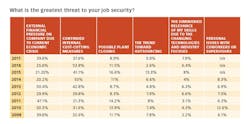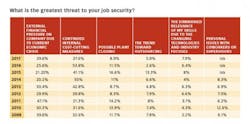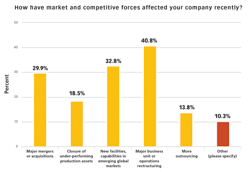For the 14th consecutive year, Pharmaceutical Manufacturing readers have provided insightful feedback on careers and salaries through our annual survey. We query readership to gain a sense of how their pharma careers are treating them — both financially and emotionally — and speculate on how those answers reflect the bigger industry picture.
ABOVE AVERAGE SATISFACTION
Job satisfaction in the pharmaceutical industry remains good — more than 89 percent reported their satisfaction levels within the range of “very high” to “OK,” which is exactly the same as last year’s survey.
Results varied by respondent demographics. Of the 307 respondents who indicated their gender, 94.5 percent of women were in the very high to OK range, and 88.5 percent of men reported as such. When broken down by industry segments, those working for consulting companies reported the greatest amount of job satisfaction, with a whopping 79 percent ranking their satisfaction levels from high to very high. This was followed by small to mid-sized specialty pharma manufacturers, which had 61.6 percent reporting high to very high satisfaction levels.
Overall job satisfaction has been on the rise in the U.S., but even so, only just recently (in 2017) surpassed the 50 percent mark — so it would appear as though the pharma industry is way above average.¹DEFINING SATISFACTION
While “satisfaction” can be a subjective state, our survey asked readers which specific factor contributed most to their overall level of satisfaction. When asked about a variety of factors, among them challenging work, salary and benefits, opportunity for advancement, job security, stress levels and work/life balance, just over 25 percent ranked challenging work as the most important contributing factor. This was closely followed by 23 percent who ranked salary and benefits as the most important factor. While this ranking order has stayed consistent for the past six years, the gap between the perceived importance of challenging work versus salary is shrinking.
Additionally, job security and appreciation slightly declined in importance since last year, while low-stress environments and opportunity for advancement gained votes.
These results were corroborated by a write-in question, where respondents were asked what satisfies them most about their current position. Many respondents pointed out that their jobs offer new challenges and new problems to solve — and that projects are unique, interesting and diversified. Overall, respondents feel good about helping people, and find satisfaction in the belief that they are making a difference for their companies and for patients. “My company is making a major impact on improving the quality of patients’ lives,” said one respondent.
Interestingly, while only 11 percent said that work/life balance is the most important factor when it comes to overall job satisfaction, many said that freedom — in terms of working environments and work/life balance — is what they like most about their jobs. Respondents enjoy having the ability to make decisions independently as well as the perks of flexible hours, understanding employers and time-off.
TALKING MONEY
Compensation appears to be healthy and reflects the sustained recovery of the pharma industry in 2017. Just over 25 percent of those surveyed have gross annual salaries between $100,000-150,000, with the next largest group (20%) making $150,000-200,000 annually. And 14.4 percent of respondents indicated their salaries are above $200,000.
According to survey results, both seniority and education factor into salaries. The majority (78 percent) of those who report gross yearly salaries exceeding $100,000 have more than 10 years of experience in the industry. Additionally, 67 percent of those who report salaries exceeding $100,000 have postgraduate degrees.
In this year’s survey, almost 65 percent of respondents reported getting raises last year, with most (77 percent) seeing an increase of 3-5 percent. Just 10.5 percent of those who reported earning raises said their salaries were increased by more than 10 percent.
These numbers are slightly down from year’s survey, where a greater percentage of respondents reported getting raises (70 percent), as well as a greater percentage (13 percent) seeing raises higher than 10 percent. This small drop in wage increases was projected on a global level, however. A Hay’s Group 2017 forecast predicated that, adjusted for inflation, workers around the world are were expected to see real wage increases of 2.3 percent (down slightly from 2016’s prediction of 2.7 percent).2
SECURITY IN TODAY'S MARKET
For the pharmaceutical industry, 2017 was challenged with a new administration that was both unpredictable and unconventional, a new FDA commissioner, and high levels of scrutiny surrounding drug prices and opioid use.
Despite all obstacles, 2017 saw the pharmaceutical sector bouncing back from what many analysts referred to as a “lackluster 2016.”3 The past year saw major advances in innovation, specifically in immunotherapy, stem cells and personalized medicines, as well as a higher number of drug approvals.
When asked how current market and competitive forces affected their companies, 41 percent of respondents noted major business unit or operations restructuring. This answer has remained in the top spot since we started asking the question in 2014. This year, 33 percent said market pressure resulted in the launch of new facilities and capabilities in emerging global markets.
Major mergers, acquisitions and outsourcing both saw a decline in this year’s survey, with only 30 percent of respondents noting the effects of M&A and 14 percent acknowledging outsourcing increases.
This is in line with market reports, as 2017 saw an unusual stagnation in pharma M&A4 as well as a decrease in pharma spending on outsourcing activities.5 Many experts speculate that pharma spent much 2017 on pause, waiting to see how tax reforms and cash repatriation will shake out before making any major decisions.
Despite a year of uncertainty, it appears as though policy from the new administration will work out in pharma’s favor and survey results reflect continued positive attitudes about job security. When asked if they were more or less concerned about job security than last year, just 30 percent of those surveyed noted increased concern. While similar to last year’s numbers, these percentages are way down from previous years (52.5 percent in 2016 and 48 percent in 2015).
Those who were wary of job security pointed almost equally to two top threats: “External financial pressure on my company due to expiring patents or circumstances surrounding failed product development or regulatory approval” (40 percent) and internal cost-cutting measures (38 percent). This is a sweeping shift in data from last year, where over 50 percent were concerned with internal cost-cutting and only 26 percent pointed to external financial pressure as the top threat. In fact, starting in 2012, surveys have revealed a shift from concerns about external financial pressure towards internal cost cutting — this year has halted that trend.
REAL TALK: CHALLENGES
While several studies have found that moderate amounts of stress are actually beneficial in the workplace6 (when the body and brain are moderately stimulated by stress, decision-making, learning and the formation of memories are all enhanced), too much stress has the opposite effect. Has pharma found the right balance? According to the survey, 57 percent of readers feel overly stressed some of the time at work, while 21 percent feel overly stressed most of the time.
While the survey results overall were positive, when put on the spot to describe what made them least satisfied about their current position, readers responded with honestly. Stress again took center stage, with respondents describing their jobs as “crazy busy” and mentioning the “high level of stress related to over-commitment.” Stress was seemingly worsened by management and red tape, with respondents pointing out “how simple processes can be turned into complex processes due to bureaucracy” and lamenting the “internal bureaucratic hurdles to efficiently developing processes.”
A lack of clarity and transparency was also a frequent complaint. Similar to years past, management and senior leadership bore the brunt of the criticism with readers bemoaning the “siloed style of management at the corporate level” and “unclear strategic plans from senior management.” Many noted the lack a of clear path to advancement opportunities. In fact, 46 percent ofrespondents said they do not receive meaningful feedback on job performance on a yearly basis.SURVEY DEMOGRAPHICS
This year’s study yielded 350 total responses. Examining demographic profiles revealed by Pharmaceutical Manufacturing’s respondents, participants were predominately North American-based (70 percent), with the remainder of respondents dispersed in Europe (9 percent), Asia (6.5 percent), India (6.5 percent), the Middle East, Africa and Latin America.
This year, 76 percent of survey respondents were male and 24 percent female — the largest percentage of women respondents we’ve had in survey history.
The majority of respondents (74 percent) were 40 or older, with most possessing degrees in either chemistry, chemical engineering or pharmaceutics. According to survey results, 20 percent fill R&D rolls, 19 percent are in quality assessment and QC, and 17 percent in manufacturing and operations. Corporate management, plant engineering and design, process control and regulatory functions were also represented.
Industry longevity dominated, with 79 percent of responding readers having seven or more years of industry experience — and an impressive 46 percent of total respondents boasting more than 20 years of pharma industry experience. Not surprisingly, over 62 percent are in supervisory roles, with 14 percent in charge of supervising more than 15 people.
Responding readers represented the panoply that is the pharma industry, with 20 percent from Big Pharma, 19.5 percent from small and mid-sized specialty manufacturers, 15 percent from generic pharma, 10.5 percent from contract pharma and 10 percent from biopharma. The remainder, including consultancies, vendor/solution providers and all others, accounted for about 25 percent of the total pie.
REFERENCES
1. More Than Half of US Workers are Satisfied with Their Jobs. The Conference Board (Sept 2017).
2. 2017 Global Salary Forecast. Hay Group.
3. EP Vantage 2018 Pharma & Biotech Preview. EvaluatePharma.
4. Flanagan, Cristin. Analysts Cross Fingers for 2018 Return of BioPharma Mega-Mergers. Bloomberg Technology (Dec 2017).
5. 2017 Contract Development and Manufacturing Survey. Nice Insight.
6. Eltringham, Mark. Moderate Stress Levels Can Enhance Performance. Insight Publishing (April 2014).










